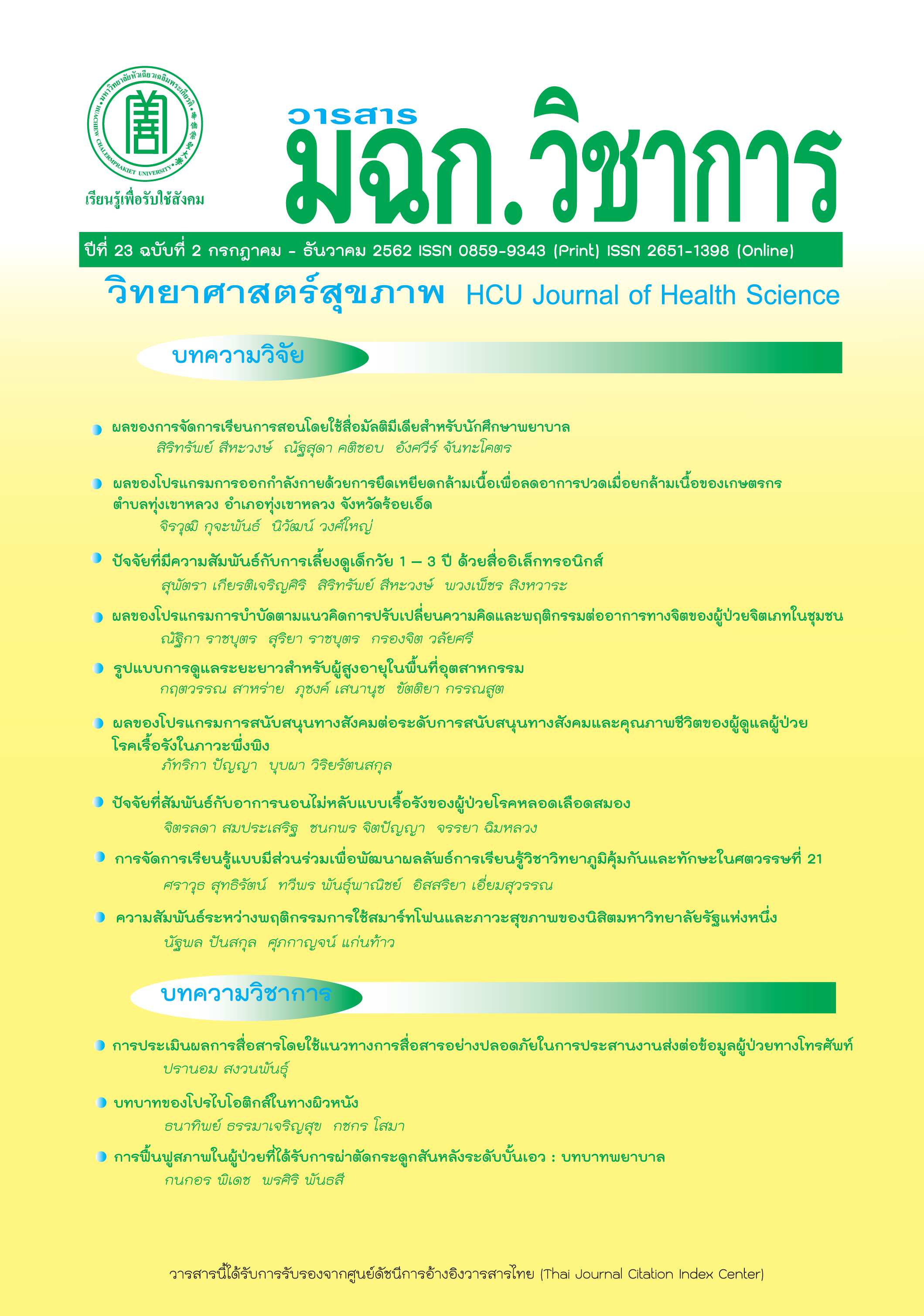รูปแบบการดูแลระยะยาวสำหรับผู้สูงอายุในพื้นที่อุตสาหกรรม
Keywords:
long-term care model, dependent elderly, industrial AreaAbstract
Abstract
This research is a mixed methods research composed of quantitative and qualitative research. The objectives are to study the situation, needs, and problems of long-term care (LTC), analyze policy, plan, mechanism and present LTC model for the elderly in the industrial area. The sample population is 3,130 elderly people who are dependent on Samutprakarn Province and 355 people randomly selected, collect data by using questionnaires along with in-depth interviews with those involved in LTC 31 people, analyzed by descriptive statistics and content analysis.
The study found that the situation, needs, and problems of LTC, 70.1% of the dependent elderly who had the Barthel Activities of Daily Living: ADL score of 5-11, while 29.9% of elderly at ADL score equal or less than 4, 98.6% of the elderly were sick and most was non-communicable diseases, 42.3% needed someone to take care all the time, 41.4% had cared for an uncertain period and 16.3% were left alone. The dependent elderly who need LTC service was at a high level (mean 3.47) ranging from community service (mean 3.70) followed by the home service (mean 3.43) and Institutional services (mean 3.11) respectively. The overall problem of LTC was at a high level (mean 3.63). Performance in the years 2016 - 2019, 22 local administrative organizations were participating in the LTC program for a total of 48 locations. There were 79 care managers (CM), caregivers (CG) of 477 people, conducted a care plan of 1,423 cases, disbursed 70.77%. According to the findings, the researcher presents the LTC model by dividing the elderly into 3 groups. Group 1: 40-59 years old should focus on promoting health and preventing chronic infectious diseases (non-communicable diseases: NCDs). Group 2: 60 or older should be prepared to enter the LTC system. Group 3: older people who can help themselves should promote health and prevent disease. Classification of the elderly should assess ADL together with family and community because in the industrial area there is a problem with limited time in caring for the elderly and being an urban society. In service, emphasizing community service and home services, management of local administrative organizations to prepare a memorandum of cooperation with relevant agencies so that all sectors are involved in caring for the elderly and developing a sustainable system.
Downloads
References
2. Thai Elderly Research and Development Institute Foundation and Institute for Population and Social Research Mahidol University.Thai Elderly Situation 2015. Bangkok: Amarin Printing and Publishing Public Company Limited; 2016.
3. National Health Security Office (NHSO). Strategic plan for the implementation of long-term care systems for the elderly in dependency, 2014-2018. Bangkok: National Health Security Office (NHSO); 2014.
4. Samutprakan Provincial Industry Office. Report of the number of industrial work in Samut prakan Province in 2016.
5. Yamane T.Statistical an introductory analysis. New York: Harper & Row; 1973. Cited in Boontham kitpridabrisut. Statistical analysis for research. 5th edition, Bangkok: Kaew Kaew Printing; 2010.
6. National Health Security Office (NHSO). Manual of long-term health care system for elderly people with long-term dependency in the national health insurance system, fiscal year 2016. Bangkok: National Health Security Office (NHSO); 2016. pp. 19-20.
7. Sumrit Srithamrongsawat et al. The complete report of the research project for the development of a long-term care system for elderly people with dependency under the national health security system. Faculty of Medicine Ramathibodi Hospital Mahidol University and Health Systems Research Institute (HSRI); 2018. pp. 100-101.
8. Office of the National Economic and Social Development. National Economic and Social Development Plan No. 12. Bangkok: Office of the Prime Minister; 2016.
9. World Health Organization. World Report on Ageing and Health. Geneva; 2015.
10. Narirat Jitmontri, Wilaiwan Thongcharoen, Sawitree Yanyasin. Study of good elderly care model of urban communities. Bangkok: Health Systems Research Institute (HSRI) Foundation of Thai Elderly Research and Development Institute; 2009.
11. Ayumi Igarashi, Tomoaki Ishibashi ,Tomohiro Shinozaki and Noriko Yamamoto-Mitani. Combinations of long-term care insurance services and associated factors in Japan: a classification tree model. BMC Health Services Research [internet]. 2014 [Cited 2019 March 20];14 (382) :1-10. Available from:https://www.biomedcentral.com/1472-6963/14/382
Downloads
Published
How to Cite
Issue
Section
License
บทความที่ได้รับการตีพิมพ์เป็นลิขสิทธิ์ของวารสารวิทยาศาสตร์สุขภาพและสุขภาวะ
ข้อความที่ปรากฏในบทความแต่ละเรื่องในวารสารวิชาการเล่มนี้เป็นความคิดเห็นส่วนตัวของผู้เขียนแต่ละท่านไม่เกี่ยวข้องกับมหาวิทยาลัยหัวเฉียวเฉลิมพระเกียรติ และคณาจารย์ท่านอื่นๆในมหาวิทยาลัยฯ แต่อย่างใด ความรับผิดชอบองค์ประกอบทั้งหมดของบทความแต่ละเรื่องเป็นของผู้เขียนแต่ละท่าน หากมีความผิดพลาดใดๆ ผู้เขียนแต่ละท่านจะรับผิดชอบบทความของตนเองแต่ผู้เดียว




